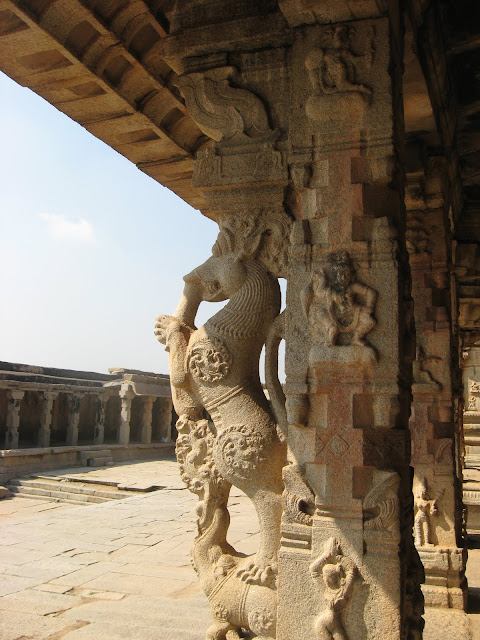The year was 1290 . A crowd had gathered around a clearing, where broken down pillars marked the presence of an ancient temple, now long gone. A young boy, just 14 years old, leaned against one of those pillars, deep in thought. Then, he began speaking, and the crowd fell silent, listening to his every word. He spoke without any notes, translating the Bhagavat Gita, from Sanskrit, which only the pundits knew, to the language everyone in the village knew and spoke – a variety of Prakrit which developed into the Marathi language. Even as he spoke, one of the men in the audience realized how momentous this event was, and how important this composition would be. He began writing down the words the young boy spoke, and this composition was named by its author and composer, the Bhavartha Deepika – the enlightening meaning (of the Bhagavat Gita). Now, the ancient, holy text, was no longer restricted to the pundits, but accessible to all, understood easily by them, composed as it was, in their...
The Krishna temple at Hampi was built by Krishnadevaraya to commemorate the success of his Orissa campaign. It is believed that he brought back with him, an idol of Bala Krishna – Krishna, the child – which was enshrined in this temple.
The figure of Krishna depicted at the top of the gopuram (or rather, what is left of it), is probably what the Krishna idol looked like…..
Or maybe he was like this depiction on the pillar … no one knows for sure now!
The gopuram is covered with detailed stucco figures of warriors, probably depicting the conquest of Orissa.
Here is the main shrine….
With tales of Lord Vishnu and his devotees etched on the walls and pillars…
The main sanctum is nothing more than a dark chamber… filled with bats and smelling of bat dung… I didn’t even try to venture inside, but Samhith did, with a couple of others from our group!
This is one empty shrine left outside… which once housed one of the doorkeepers of Lord Vishnu….
The doorways have interesting carvings… from Ganesha to the other deities..
And the ten incarnations of Lord Vishnu…
The beam on top shows the Moon (shown with the rabbit in it) being attacked by the snake-like demons Rahu and Ketu…
Outside the temple is a huge Hundi – a collection box – which is almost as tall as me. I had to stand on the base to get a pic of the hole through which the coins were put in!
Opposite the temple is a clearing – this was once a huge bazaar. Today, there is just a plain stretch of land, with a pathway marking the edge…
In the recent past, this was once a field, most probably a banana plantation. As I wandered along the stone paved area, I wondered about right and wrong – whether we were justified in evacuating villagers whose families had tended the land for hundreds of years, just because underneath it was a civilization which existed before they arrived!
These covered pathways have withstood the wear and tear of the years……
While this one has been cleaned and cleared, for tourists like us to walk on, there are more like this all over the place… like this one, for instance, which is now a car park……
Samhith was fascinated, and when we spoke about how difficult it would have been to build, without machines, he tried to lift one of the small stones lying about…. Needless to say, he was convinced!
Adjacent to this clearing is this…..
It was probably the place the merchants had their apartments….. More than anything, it was such things that brought the place alive in my eyes….
And this was the tank….. Used to supply water to the people using the bazaar…
There is a water channel bringing water from the main aqueduct….
The attention paid to detail is amazing! Even something as simple as a pillar holding up a mandap or pavilion near the tank is decorated, and aptly, with leaves and flowers.
While another pavilion on the road nearby has decorative patterns or images of people!
It is this which makes Hampi such an interesting place to be in, and it would take days to just wander around, seeing such small things which made the ancient city so admired and famous!








































Very informative with some very nice photos, but with one factual error. Speaking about the figure of Balakrishna that must have been inside the Krishna temple, it is said:
ReplyDeleteThe figure of Krishna depicted at the top of the gopuram (or rather, what is left of it), is probably what the Krishna idol looked like….. Or maybe he was like this depiction on the pillar … no one knows for sure now!
But in fact we know exactly what the Balakrishna statue looked like, because the statue was found in the ruins of the temple. It was then taken to Chennai, where it now resides in the Chennai Museum. See this article from The Hindu to learn more:
http://www.thehindu.com/opinion/blogs/blog-datum-line/article4177684.ece
--Pankaj Tandon
Thank you so much, Mr Tandon, for bringing this to my notice. I had no idea of this, and in fact, hadnt heard of this even from the guides at Hampi. I shall def add it to the article.
Delete